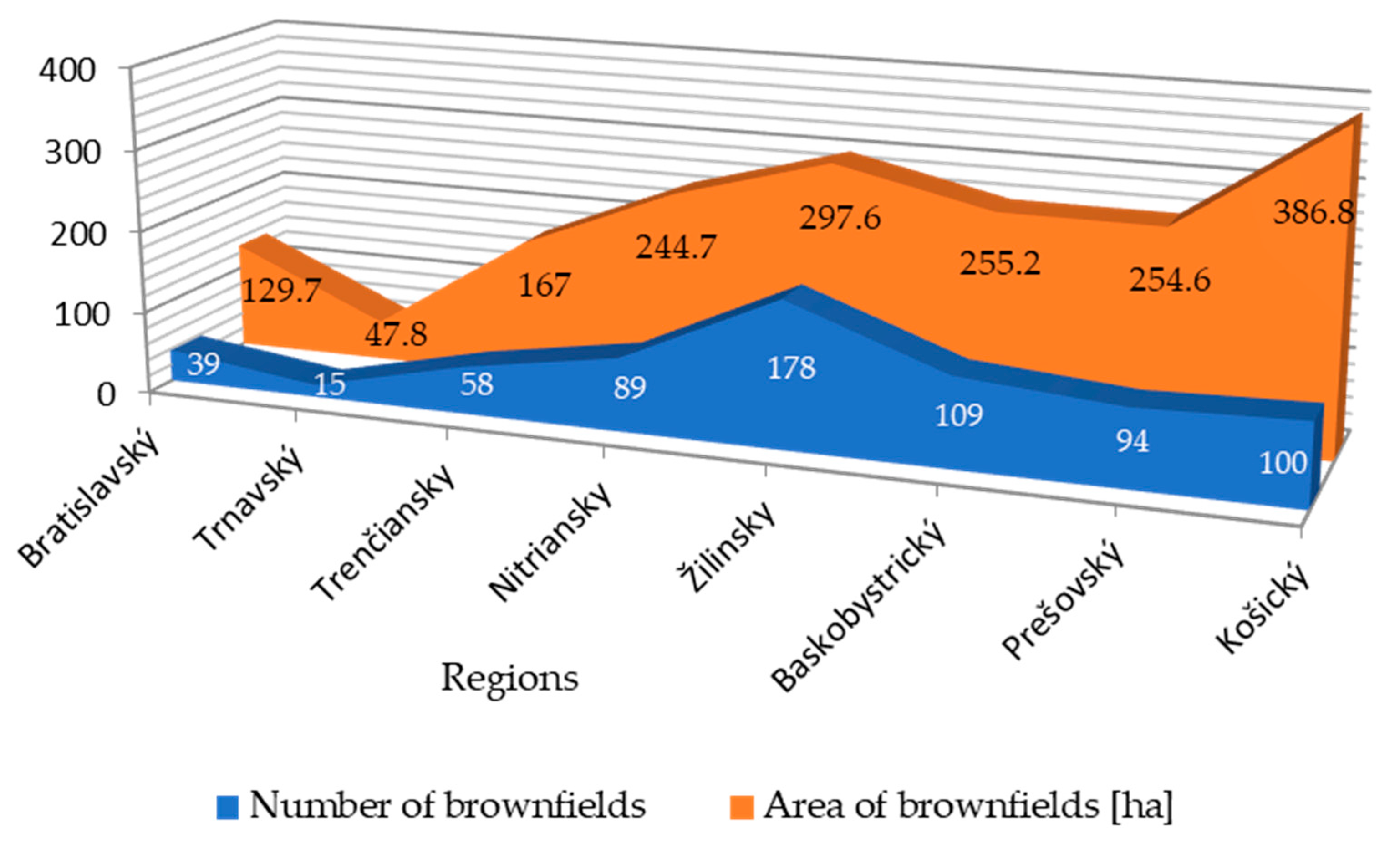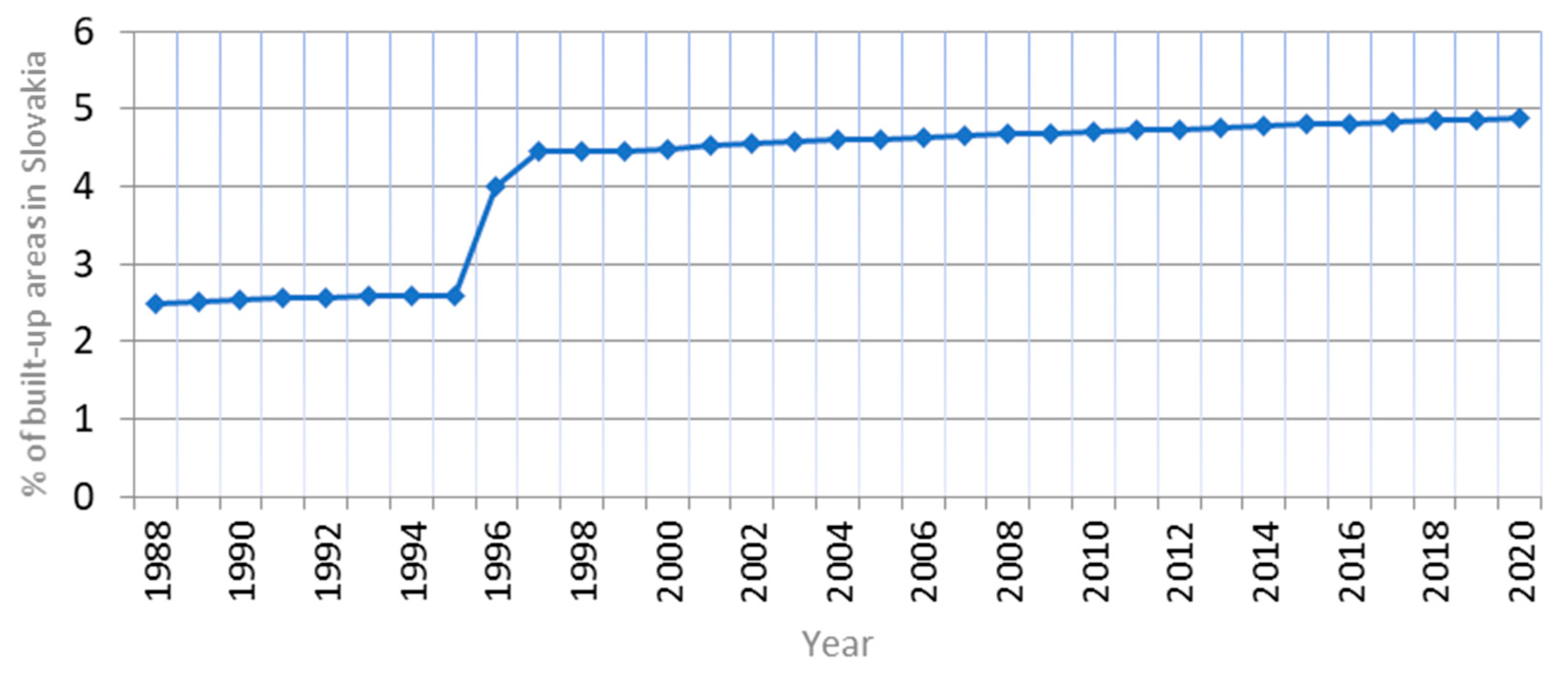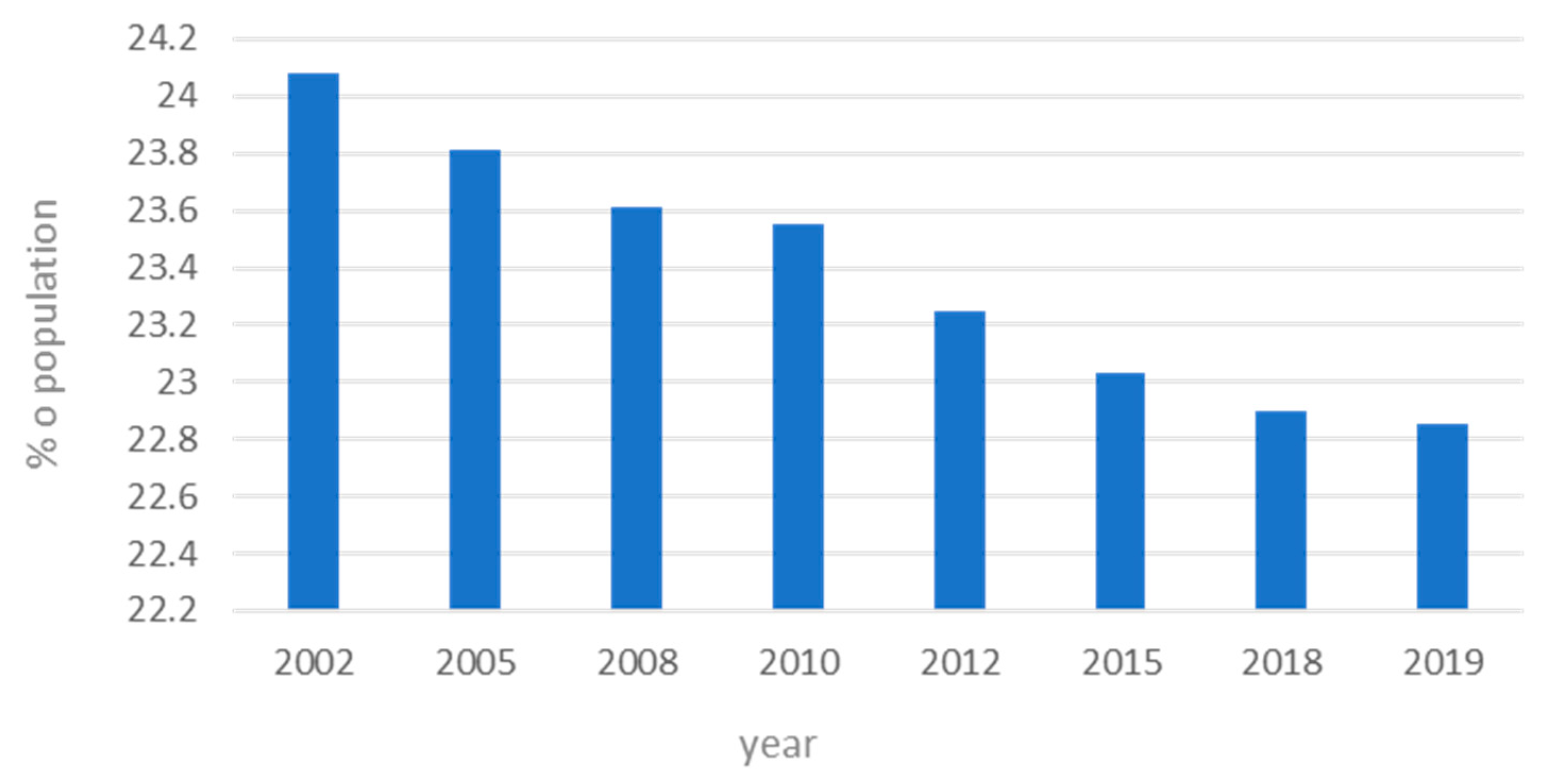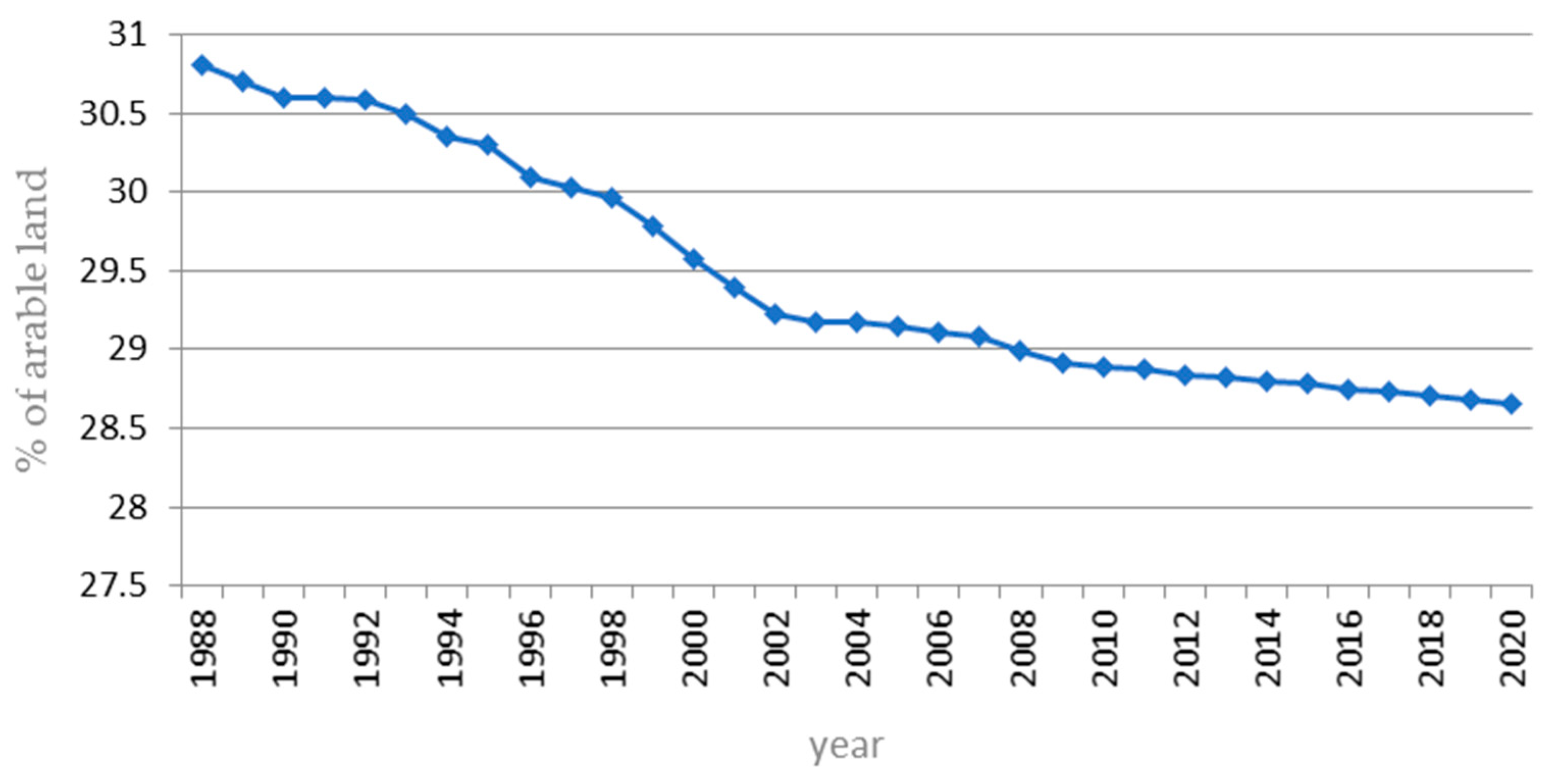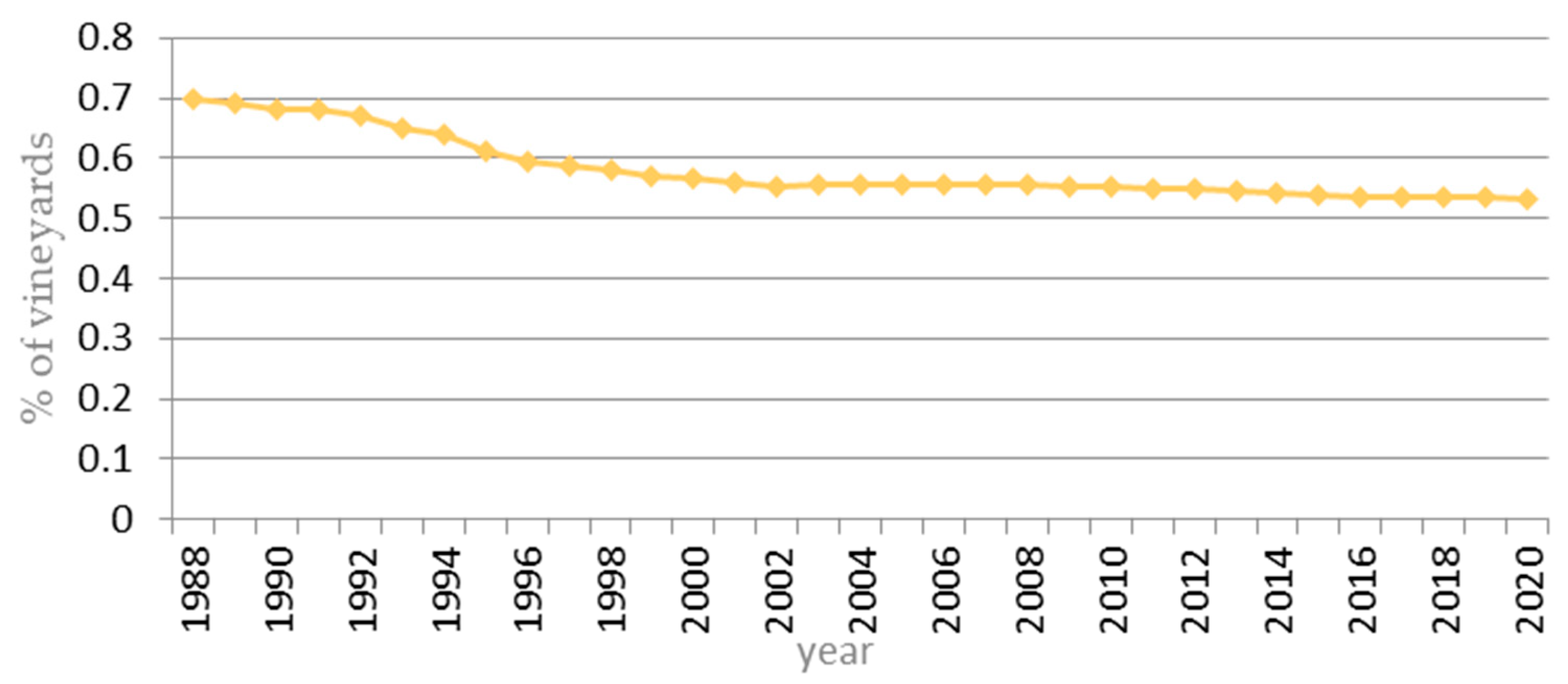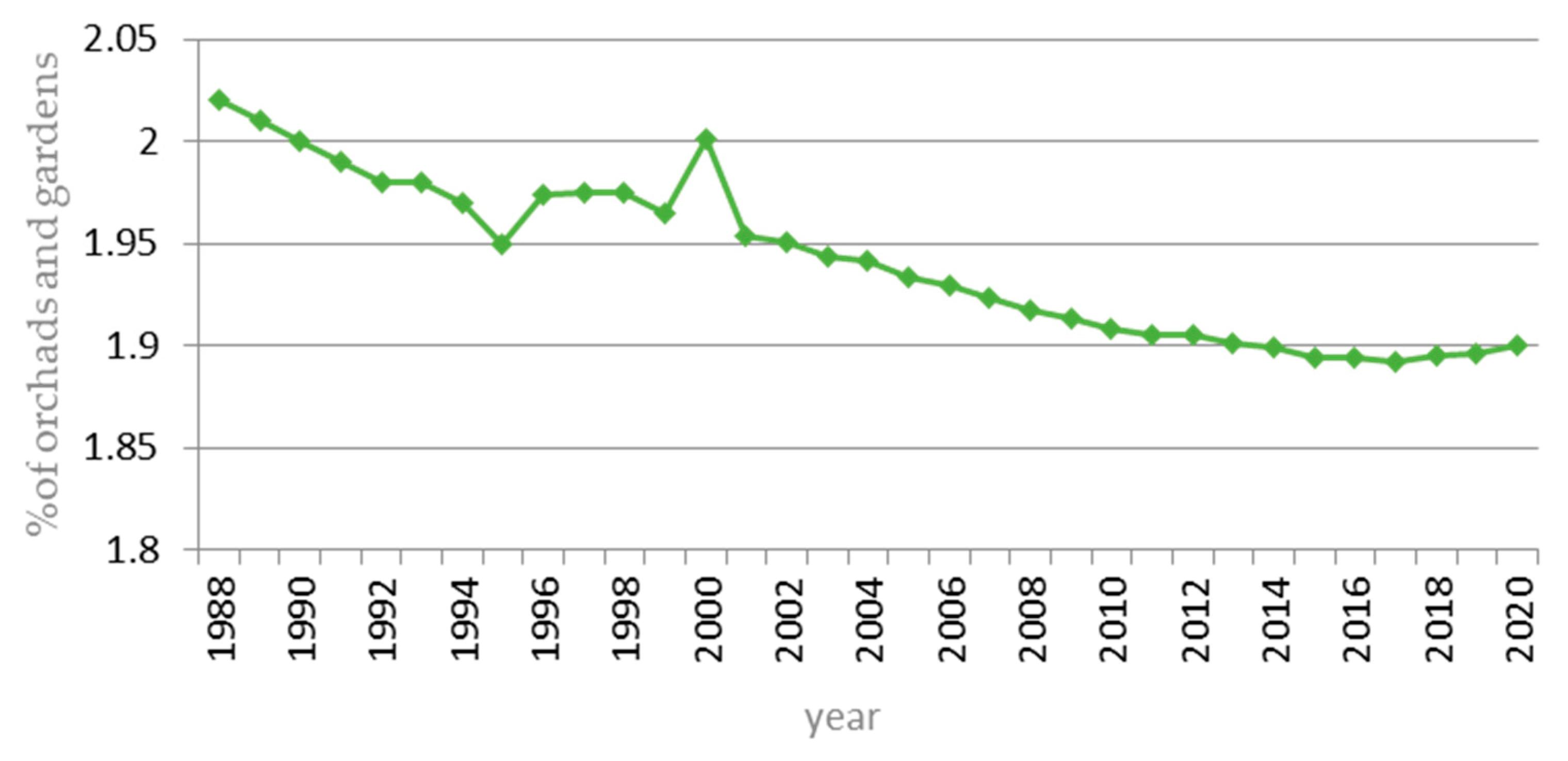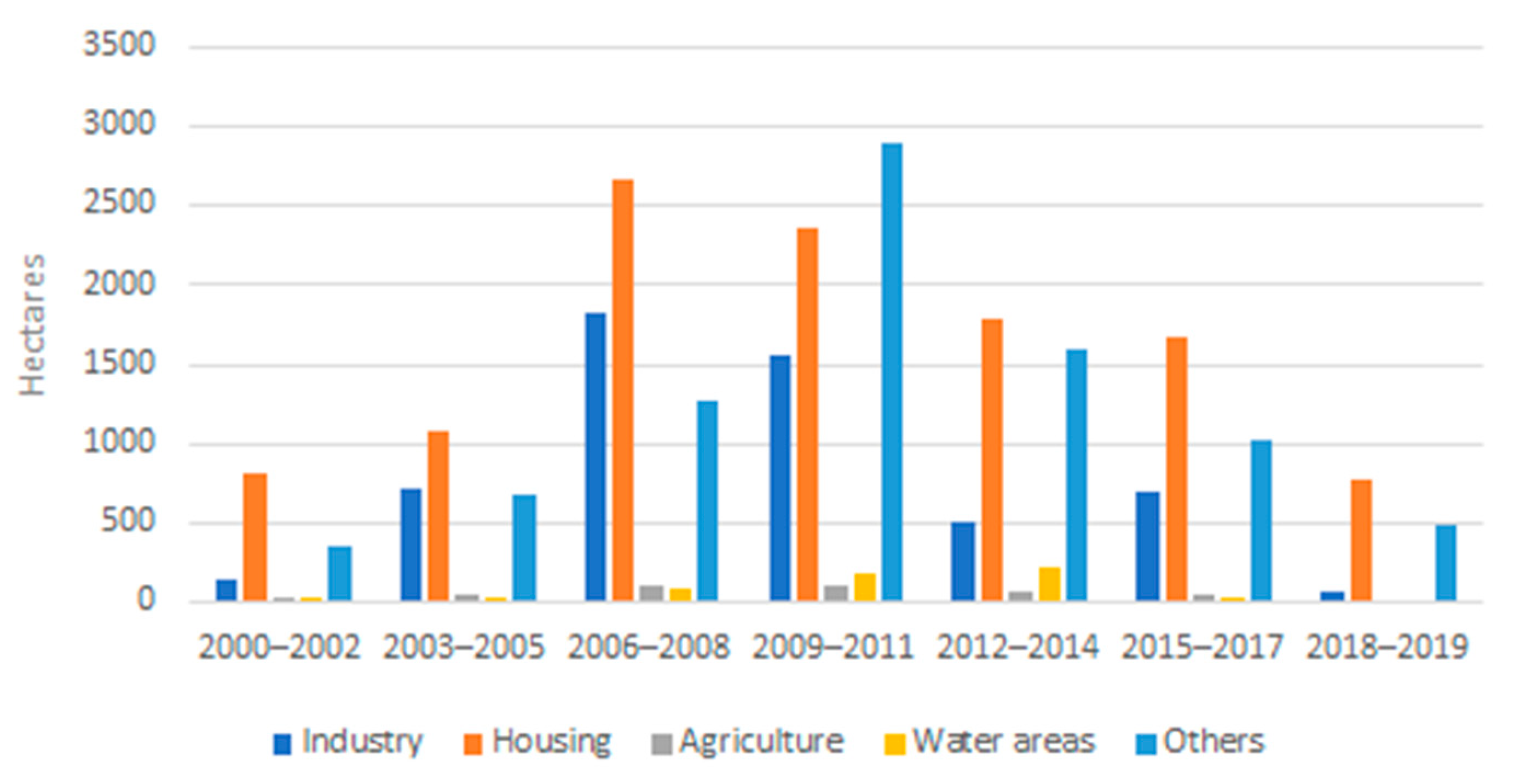The Impacts of Urbanisation on Landscape and Environment: The Case of Slovakia
Abstract
1. Introduction
- The transformation process in Slovakia caused a rapid growth of industrialisation and urbanisation, which was subsequently reflected in the growth of anthropisation of the territory and creation of brownfields of new anthropogenic objects built on areas which were originally arable land or vegetation areas (green areas).
- The development of industrialisation, urbanisation and suburbanisation changes the image and nature of the traditional landscape, and it also reduces the visibility of many attractive and rare landscape types—many historical landscape structures are endangered and disappearing.
- The development of urbanisation is connected with the threat to natural resources and also to a loss of biodiversity—reducing the share of natural ecosystems, gene pool areas, occupation of quality soils and reducing green areas, etc.
- The increase in built-up areas is not conditioned by population growth, but rather is a consequence of a change in lifestyle.
2. Materials and Methods
- The map of soil-ecological units of Slovakia, which represents the main soil-climatic units, which are divided in more detail according to the categories of their slope, slope exposure to the cardinal directions, skeletality, soil depth and grain size of the surface horizon and reflects soil quality based on soil valuation [51]. This map is the basis for assessing the impact of urbanisation on soil resources;
3. Results
4. Discussion
- Irreversible land use change—urbanisation changes the natural landscape into semi-natural and artificial, increases the degree of anthropisation, reduces the spatial ecological stability of the area, causes landscape fragmentation, threatens the migratory movement of biota and threatens biodiversity [69,70];
- Persistent pressures of investors on the occupation of natural resources—construction is mostly performed on agricultural and forest land, which is associated with the scope of natural resources, natural ecosystems, rare historical landscape structures—vineyards (also historical vineyards with the highest landscape value), orchards and vegetation areas. For Slovakia, the area of the highest quality soils for development is also typical, especially for the construction of industrial parks and buildings; occupancy, an increase in built-up areas and impermeable surfaces worsen the adaptation landscape balance;
- Change in the use of ecosystem services—the process of urbanisation negatively affects the ecosystem services [12,71,72,73], including food production, gene pool protection, regulation natural processes, endangering natural aesthetic values; these do not create the right conditions for the landscape to adapt to the effects of a changing climate;
- Changes in the image of the villages and rural country—the growth of new residential areas inappropriate for rural areas (unsuitable architectonic design of constructions), loss of the nature of rural gardens near houses in rural settlements, inappropriate landscaping around the rural houses (paved areas, inappropriate plant species). These processes are also reflected in the reduction of the aesthetic value of the landscape;
- Lifestyle change in rural settlements—population growth in peri-urban areas, transfer of the elements of an urban lifestyle into the countryside, decline in community life, increasing manifestations of separation, egoism, etc. [66];
- Negative impact on climate change—increasing share of built-up areas reduces seepage, accelerates water run-off, increasing risk of floods as well as overheating of surfaces and the creation of heat islands [13];
- Increase in traffic intensity and associated negative effects—the relocation of the population to the rural environment caused an increase in transport, especially daily attendance for work, which subsequently caused increased noise, dust but especially increased production of traffic fumes.
5. Conclusions
Author Contributions
Funding
Acknowledgments
Conflicts of Interest
References
- Czepczyński, M. Interpreting Post-Socialist Icons: From Pride and Hate Towards Disappearance and/or Assimilation Human Geographies. J. Stud. Res. Hum. Geogr. 2010, 4, 67–78. [Google Scholar]
- Ilchenko, M.; Dushkova, D. Transformations of urban space after the fall of Socialism. Editorial: In search of the post-socialist urban geography. How do we see the post-socialist city today? Belg. Rev. Belg. De Géographie 2018, 4, 6. [Google Scholar] [CrossRef]
- Grochowska, A.; Martyna, M. Potential Conflicts in The Land-Use Planning Process: A Case Study of the Rural Commune of Oleśnica (Poland). Quaest. Geogr. 2020, 39, 129–137. [Google Scholar] [CrossRef]
- Lutz, W.; O’Neill, B.C.O.; Scherbov, S. Europe’s population at a turning point. Science 2003, 299, 1991–1992. [Google Scholar] [CrossRef]
- European Environmental Agency—EEA. Indicator Fact Sheet Signals 2001–Chapter ‘Households’; Luxembourg: Office for Official Publications of the European Communities: Copenhagen, Denmark, 2001. [Google Scholar]
- European Environmental Agency—EEA. Land Accounts for Europe 1990–2000; Towards Integrated Land and Ecosystem Accounting. EEA Report 11; Luxembourg: Office for Official Publications of the European Communities: Copenhagen, Denmark, 2006. [Google Scholar]
- European Environmental Agency—EEA. Time for Action–Towards Sustainable Consumption and Production in Europe; EEA Technical Report 1; Luxembourg: Office for Official Publications of the European Communities: Copenhagen, Denmark, 2008. [Google Scholar]
- Kabisch, N.; Haase, D. Diversifying European agglomerations: Evidence of urban population trends for the 21st century. Popul. Space Place 2011, 17, 236–253. [Google Scholar] [CrossRef]
- Ogden, P.E.; Schnoebelen, F. The Rise of the Small Household: Structure in Paris. Popul. Bull. 2005, 268, 251–268. [Google Scholar]
- Lesthaeghe, R. Europe’s demographic issues: Fertility, household formation and replacement migration. Popul. Bull. U. N. 2002, 44/45, 385–423. [Google Scholar]
- Liu, J.; Daily, G.C.; Ehrlich, P.; Luck, G.W. Effects of household dynamics on resource consumption and biodiversity. Nature 2003, 421, 530–532. [Google Scholar] [CrossRef]
- Saarikoski, H.; Primmer, E.; Saarela, S.R.; Antunes, P.; Aszalós, R.; Baró, F.; Berry, P.; Blanco, G.G.; Gómez-Baggethun, E.; Carvalho, L.; et al. Institutional challenges in putting ecosystem service knowledge in practice. Ecosyst. Serv. 2018, 29, 579–598. [Google Scholar] [CrossRef]
- Belčáková, I.; Diviaková, A.; Belaňová, E. Ecological footprint in relation to climate change strategy in cities. Mater. Sci. Eng. 2017, 245, 1–7. [Google Scholar] [CrossRef]
- Kong, D.; Gu, X.; Li, J.; Ren, G.; Liu, J. Contributions of global warming and urbanization to the intensifcation of human-perceived heatwaves over China. J. Geophys. Res. Atmos. 2020, 125, e2019JD032175. [Google Scholar] [CrossRef]
- Wang, J.; Chen, Y.; Liao, W.; He, G.; Tett, S.F.B.; Yan, Z.; Zhai, P.; Feng, J.; Ma, W.; Huang, C.; et al. Anthropogenic emissions and urbanization increase risk of compound hot extremes in cities. Nat. Clim. Chang. 2021, 11, 1084–1089. [Google Scholar] [CrossRef]
- Kotus, J. Changes in the spatial structure of a large Polish city—The case of Poznan. Cities 2006, 23, 364–381. [Google Scholar] [CrossRef]
- Hirt, S. Suburbanizing Sofia: Characteristics of Post-Socialist Peri-Urban Change. Urban Geogr. 2007, 28, 755–780. [Google Scholar] [CrossRef]
- Bajmócy, P. Suburbanisation and suburban regions in Hungary after 1990. In Development of the Settlement Network in the Central European Countries: Past, Present, and Future; Csapó, T., Balogh, A., Eds.; Springer: Heidelberg, Germany, 2012; pp. 207–221. [Google Scholar]
- Ehrlich, K.; Kriszan, A.; Lang, T. Urban Development in Central and Eastern Europe—Between Peripheralization and Centralization. Plan. Rev. 2012, 48, 77–92. [Google Scholar] [CrossRef]
- Kubeš, J. European post-socialist cities and their near hinterland in intra-urban geography literature. Bull. Geogr. Socio-Econ. Ser. 2013, 19, 19–43. [Google Scholar] [CrossRef][Green Version]
- Lowicki, D.; Mizgajski, A. Typology of physical-geographical regions in Poland in line with land-cover structure and its changes in the years 1990–2006. Geogr. Pol. 2013, 86, 255–266. [Google Scholar] [CrossRef]
- Izakovičová, Z.; Mederly, P.; Petrovič, F. Long-term land use changes driven by urbanisation and their environmental effects (example of Trnava city, Slovakia). Sustainability 2017, 9, 1553. [Google Scholar] [CrossRef]
- Dická, J. Diferenciácia sociálno-demografickej štruktúry v zázemí mesta Košice z aspektu suburbanizácie. Geogr. Cassoviensis 2007, 1, 19–25. [Google Scholar]
- Korcelli, P.; Korcelli-Olejniczak, E.; Kozubek, E. Typologies of european urban-rural regions: A review and assessment. Geogr. Pol. 2009, 81, 25–42. [Google Scholar]
- Dmitrieva, M.; Kliems, A. The Post Socialist City: Continuity and Change in Urban Space and Imagery; Jovis: Berlin, Germany, 2010; pp. 1–208. [Google Scholar]
- Pucherová, Z.; Mišovičová, R.; Bugár, G.; Grežo, H. Changes in landscape structure in the municipalities of the Nitra District (Slovak Republic) due to expanding suburbanization. Sustainability 2021, 13, 1205. [Google Scholar] [CrossRef]
- Repaská, G.; Vilinová, K.; Šolcová, L. Trends in Development of Residential Areas in of Nitra (Slovakia) Suburban Zone of the City. Eur. Countrys. 2017, 9, 287–301. [Google Scholar] [CrossRef]
- Johnson, M.P. Environmental impacts of urban sprawl: A survey of the literature and proposed research agenda. Environ. Plan. 2001, 33, 717–735. [Google Scholar] [CrossRef]
- Felt, C.; Fragkias, M.; Larson, D.; Liao, H.; Lohse, K.A.; Lybecker, D. A comparative study of urban fragmentation patterns in small and mid-sized cities of Idaho. Urban Ecosyst. 2018, 21, 805–816. [Google Scholar] [CrossRef]
- Arnold, C.; Wilson, E.; Hurd, J.; Civco, D. 30 Years of Land Cover Change in Connecticut, USA: A Case Study of Long-Term Research, Dissemination of Results, and Their Use in Land Use Planning and Natural Resource Conservation. Land 2020, 9, 255. [Google Scholar] [CrossRef]
- Divya, Y.; Gopinathan, P.; Jayachandran, K.; Al-Quraishi, A.M.F. Color slices analysis of land use changes due to urbanization in a city environment of Miami Area, South Florida, USA. Modeling Earth Syst. Environ. 2021, 7, 537–546. [Google Scholar] [CrossRef]
- Wu, C.; Li, J.; Wang, C.; Song, C.; Chen, Y.; Finka, M.; La Rosa, D. Understanding the relationship between urban blue infrastructure and land surface temperature. Sci. Total Environ. 2019, 694, 133742. [Google Scholar] [CrossRef]
- Map Client of ZBGIS. Available online: www.geoportal.sk (accessed on 21 February 2021).
- EEA. The European Environment—State and Outlook 2020. Knowledge for Transition to a Sustainable Europe; Publications Office of the European Union: Luxembourg, 2019; p. 499. [Google Scholar] [CrossRef]
- EEA. Corine Land Cover 200 by Country: Slovakia. Available online: https://www.eea.europa.eu/data-and-maps/figures/corine-land-cover-2000-by-country-1/slovakia (accessed on 14 January 2021).
- Functional Urban Areas. Available online: https://land.copernicus.eu/ (accessed on 21 February 2021).
- Statistical Office of the Slovak Republic. Statistical Yearbook of the Slovak Republic; SAV: Bratislava, Slovakia, 1995; pp. 1–632.
- Statistical Office of the Slovak Republic. Statistical Yearbook of the Slovak Republic; SAV: Bratislava, Slovakia, 2020; pp. 1–664.
- Office of Geodesy, Cartography and Cadastre of the Slovak Republic. Statistical Yearbook on the Land Fund in the Slovak Republic According to the Data of the Real Estate Cadastre on 1 January 2020; Office of Geodesy, Cartography and Cadastre of the Slovak Republic: Bratislava, Slovakia, 2020; pp. 1–130. [Google Scholar]
- Forman, R.T.T.; Godron, M. Landscape Ecology; John Wiley: New York, NY, USA, 1986; p. 640. [Google Scholar]
- Pechanec, V.; Pavková, K.; Dobešová, Z. StraKa and Assoc.-GIS Tools for Landscape Structure Analysis. In ÚSES-Zelená Páteř Krajiny, Proceedings of the 7th Seminar “USES-Zelená Páteř Krajiny”, Brno, Czech Republic, 2–3 September 2008; Petrová, A., Ed.; Ministry of the Environment of the Czech Republic, Czech Society for Landscape Ecology: Brno, Czech Republic, 2008; pp. 43–53. [Google Scholar]
- Buček, A.; Lacina, J.; Löw, J. Territorial systems of ecological stability of landscape. Životné Prostredie 1986, 20, 82–86. [Google Scholar]
- Miklós, L. Ecological quality of cadastral territories by structure of use. In Atlas Krajiny Slovenskej Republiky; Ministry of the Environment of the Slovak Republic: Bratislava, Slovakia, 2002; pp. 1–196. [Google Scholar]
- Reháčková, T.; Pauditšová, E. Methodical procedure for determining the coefficient of ecological stability of a landscape. Acta Environ. Univ. Comen. (Bratisl.) 2007, 15, 26–38. [Google Scholar]
- Izakovičová, Z.; Miklós, L.; Drdoš, J. Krajinnoekologické Podmienky Trvalo Udržateľného Rozvoja; Veda: Bratislava, Slovakia, 1997; pp. 1–183. [Google Scholar]
- Izakovičová, Z. Ecological interpretations and evaluation of encounters of interests in landscape. Ekológia (Bratisl.) Slovak. 1995, 14, 261–275. [Google Scholar]
- Izakovičová, Z. Evaluation of the stress factors in the landscape. Ekológia (Bratisl.) Slovak. 2000, 19, 92–103. [Google Scholar]
- Izakovičová, Z.; Miklós, L.; Miklósová, V.; Petrovič, F. The integrated approach to landscape management-experience from Slovakia. Sustainability 2019, 11, 4554. [Google Scholar] [CrossRef]
- Miklós, L.; Izakovičová, Z. Atlas of Representative Geocecosystems of the Slovakia; Slovak Academy of Sciences: Bratislava, Slovakia, 2006; p. 123. [Google Scholar]
- State Nature Conservancy of the Slovak Republic. NATURA 2000—Sústava Chránených Území Členských Krajín EÚ. Available online: www.sopsr.sk/natura/index1.php?p=3&lang=sk (accessed on 14 March 2021).
- Soil Map of Slovakia. Available online: http://www.podnemapy.sk/default.aspx (accessed on 21 January 2021).
- Hreško, J.; Kanasova, D.; Petrovič, F. Landscape Archetypes as the Elements of Slovak Historical Landscape Structure. Ekol. Bratisl. Slovak. 2010, 29, 158–173. [Google Scholar] [CrossRef]
- Špulerová, J.; Bezák, P.; Dobrovodská, M.; Lieskovský, J.; Štefunková, D. Traditional agricultural landscapes in Slovakia: Why should we preserve them? Landsc. Res. 2017, 42, 891–903. [Google Scholar] [CrossRef]
- Slovak Hydrometeorology Institute, Dept. of Climatology Services; Ministry of the Environment of the Slovak Republic. Environmental Report of the Slovak Republic 2018-Parts: Air and Climate Change. 2019. Available online: https://www.enviroportal.sk/spravy/detail/9341 (accessed on 21 August 2021).
- Moss, R.H.; Edmonds, J.A.; Hibbard, K.A.; Manning, M.R.; Rose, S.K.; Van Vuuren, D.P.; Carter, T.R.; Emori, S.; Kainuma, M.; Kram, T.; et al. The next generation of scenarios for climate change research and assessment. Nature 2010, 463, 747–756. [Google Scholar] [CrossRef] [PubMed]
- Climate Development in Slovakia. Available online: www.forestportal.sk/lesne-hospodarstvo/ekologia-a-monitoring-lesa/klimaticke-zmeny/Stranky/vyvoj-klimy-na-slovensku.aspx (accessed on 15 February 2021).
- SARIO-Slovak Investment and Trade Development Agency. Annual Report. 2009, p. 50. Available online: https://www.sario.sk/sites/default/files/content/files/sario_annual_report_2009.pdf (accessed on 15 February 2021).
- Ministry of Economy of the Slovak Republic. Analysis of Industrial Parks in the Slovak Republic. 2018; pp. 1–90. Available online: https://www.mhsr.sk/uploads/files/bRRRoRuk.pdf (accessed on 16 March 2021).
- Nestorová Dická, J.; Gessert, A.; Sninčák, I. Rural and non-rural municipalities in the Slovak Republic. J. Maps 2019, 15, 84–93. [Google Scholar] [CrossRef]
- Leetmaa, K.; Tammaru, T. Suburbanization in Countries in Transition: Destinations of Suburbanizers in the Tallinn Metropolitan Area. Geogr. Ann. Ser. B Hum. Geogr. 2007, 89, 127–146. [Google Scholar] [CrossRef]
- DATAcube. Available online: https://slovak.statistics.sk/wps/portal/ext/Databases (accessed on 10 February 2021).
- Pazúr, R.; Bolliger, J. Land changes in Slovakia: Past processes and future directions. Appl. Geogr. 2017, 85, 163–175. [Google Scholar] [CrossRef]
- Hardi, T.; Repaská, G.; Veselovský, J.; Vilinová, K. Environmental consequences of the urban sprawl in the suburban zone of Nitra: An analysis based on landcover data. Geogr. Pannonica 2020, 24, 205–220. [Google Scholar] [CrossRef]
- Haase, D.; Piorr, A.; Schwarz, N.; Rickebusch, S.; Kroll, F.; Van Delden, H.; Zuin, A.; Taylor, T.; Boeri, M.; Zasada, I.; et al. Tools for modelling and assessing peri-urban land use futures. In Peri-Urban Futures; Scenarios and Models for Land Use Change in Europe; Nilsson, K., Pauleit, S., Bell, S., Aalbers, C., Sick Nielsen, T.A., Eds.; Springer: Heidelberg, Germany, 2013; pp. 69–90. [Google Scholar]
- Kopecká, M.; Rosina, K. Identification of changes in urbanized landscape based on VHR satellite data: Study area of Trnava. Geogr. J. 2014, 66, 247–267. (In Slovak) [Google Scholar]
- Repaská, G.; Vilinová, K.; Dubcová, A.; Kramáreková, H. Sídelná identita ako fenomén v kontexte suburbanizácie (prípadová štúdia suburbia mesta Nitra). Geogr. Časopis 2015, 67, 107–126. [Google Scholar]
- Feranec, J.; Oťaheľ, J.; Kopecká, M.; Nováček, J.; Pazúr, R. Landscape Cover of Slovakia and Its Changes in the Period 1990–2012; Veda Vydavateľstvo SAV: Bratislava, Slovakia, 2018; pp. 1–160. [Google Scholar]
- Rubiera-Morollón, F.; Garrido-Yserte, R. Recent Literature about Urban Sprawl: A Renewed Relevance of the Phenomenon from the Perspective of Environmental Sustainability. Sustainability 2020, 12, 6551. [Google Scholar] [CrossRef]
- Margules, C.R.; Meyers, J.A. Biological diversity and ecosystem fragmentation—An Australian perspective. Ekistics 1992, 59, 293–300. [Google Scholar]
- Pazur, R.; Bollinger, J. Enhanced land use datasets and future scenarios of land change for Slovakia. Data Brief 2017, 14, 483–488. [Google Scholar] [CrossRef] [PubMed]
- De Groot, R.; Wilson, M.; Boumans, R. A typology for the classification, description and valuation of ecosystem functions, goods and services. Ecol. Econ. 2002, 41, 393–408. [Google Scholar] [CrossRef]
- Grunewald, K.; Bastian, O. Ecosystem Services. Concept, Methods and Case Studies; Springer: Berlin, Germany, 2015; pp. 1–312. [Google Scholar]
- Černecký, J.; Gajdoš, P.; Špulerová, J.; Halada, L.; Mederly, P.; Ulrych, L.; Duricova, V.; Švajda, J.; Černecká, L.; Andras, P.; et al. Ecosystems in Slovakia. J. Maps 2020, 16, 28–35. [Google Scholar] [CrossRef]
- Dunk, A.; Grêt-Regamey, A.; Dalang, T.; Hersperger, A. Defining a typology of peri-urban land-use conflicts—A case study from Switzerland. Landsc. Urban Plan. 2011, 101, 149–156. [Google Scholar] [CrossRef]
- Hrnčiarová, T.; Ružička, M.; Izakovičová, Z.; Hrašna, M.; Bedrna, Z.; Drdoš, J.; Supuka, J.; Miklós, L.; Berková, A. Methodical Guidelines for the Preparation of a Landscape-Ecological Plan; Ministry of the Environment of the Slovak Republic: Bratislava, Slovakia, 2000; pp. 1–136. [Google Scholar]
- Gonçalves, J.; Gomes, M.C.; Ezequiel, S.; Moreira, F.; Loupa-Ramos, I. Differentiating peri-urban areas: A transdisciplinary approach towards a typology. Land Use Policy 2017, 63, 331–341. [Google Scholar] [CrossRef]
- Tress, B.; Tress, G.; Van der Valk, A. Interdisciplinarity and transdisciplinarity in landscape studies—The Wageningen DELTA approach. In Interdisciplinary and Transdisciplinary Landscape Studies: Potential and Limitations; Tress, B., Tress, G., Van der Valk, A., Fry, G., Eds.; WUR: Wageningen, The Netherlands, 2003; pp. 8–15. [Google Scholar]
- Tress, G.; Tress, B.; Fry, G. Analysis of the barriers to integration in landscape research projects. Land Use Policy 2007, 24, 374–385. [Google Scholar] [CrossRef]
- Antrop, M.; Rogge, E. Evaluation of the process of integration in a transdisciplinary landscape study in the Pajottenland (Flanders, Belgium). Landsc. Urban Plan. 2006, 77, 382–392. [Google Scholar] [CrossRef]
- Breuste, J.; Niemela, J.; Snep, R. Applying landscape ecological principles in urban environments. Landsc. Ecol. 2008, 23, 1139–1142. [Google Scholar] [CrossRef]
- Antrop, M. Landscape change and the urbanization process in Europe. Landsc. Urban Plan. 2004, 67, 9–26. [Google Scholar] [CrossRef]
- Naveh, Z.; Lieberman, A.S. Landscape Ecology Theory and Applications; Springer: New York, NY, USA, 1993; pp. 1–360. [Google Scholar]
- Mezősi, G.; Blanka, V.; Bata, T.; Ladanyi, Z.; Kemeny, G.; Meyer, B.C. Assessment of future scenarios for wind erosion sensitivity changes based on ALADIN and REMO regional climate model simulation data. Open J. Geosci. 2016, 8, 465–477. [Google Scholar] [CrossRef]
- Finka, M.; Husár, M.; Sokol, T. Program for lagging districts as a framework for innovative approaches within the state regional development policies in Slovakia. Sustainability 2020, 12, 5419. [Google Scholar] [CrossRef]
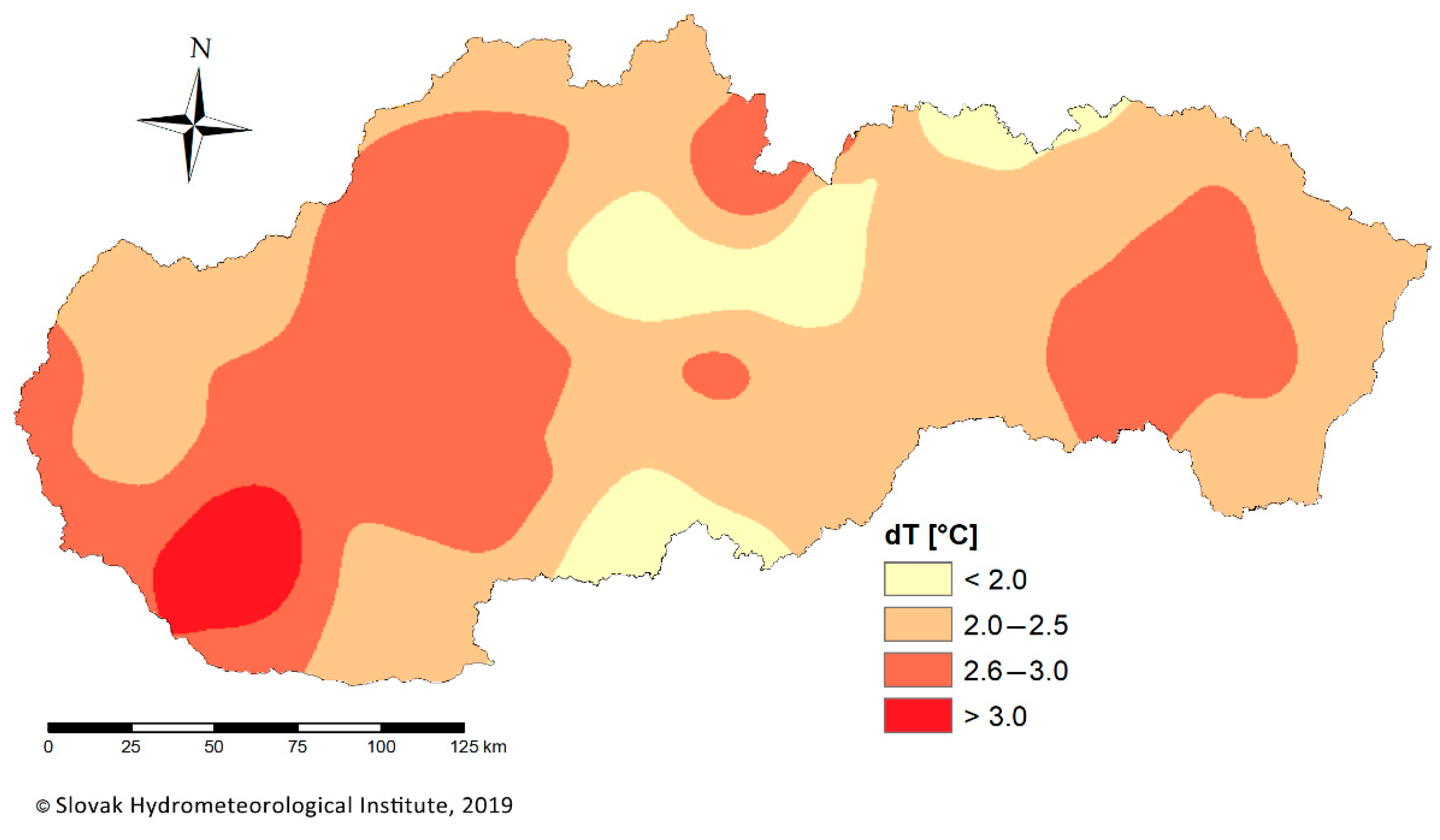
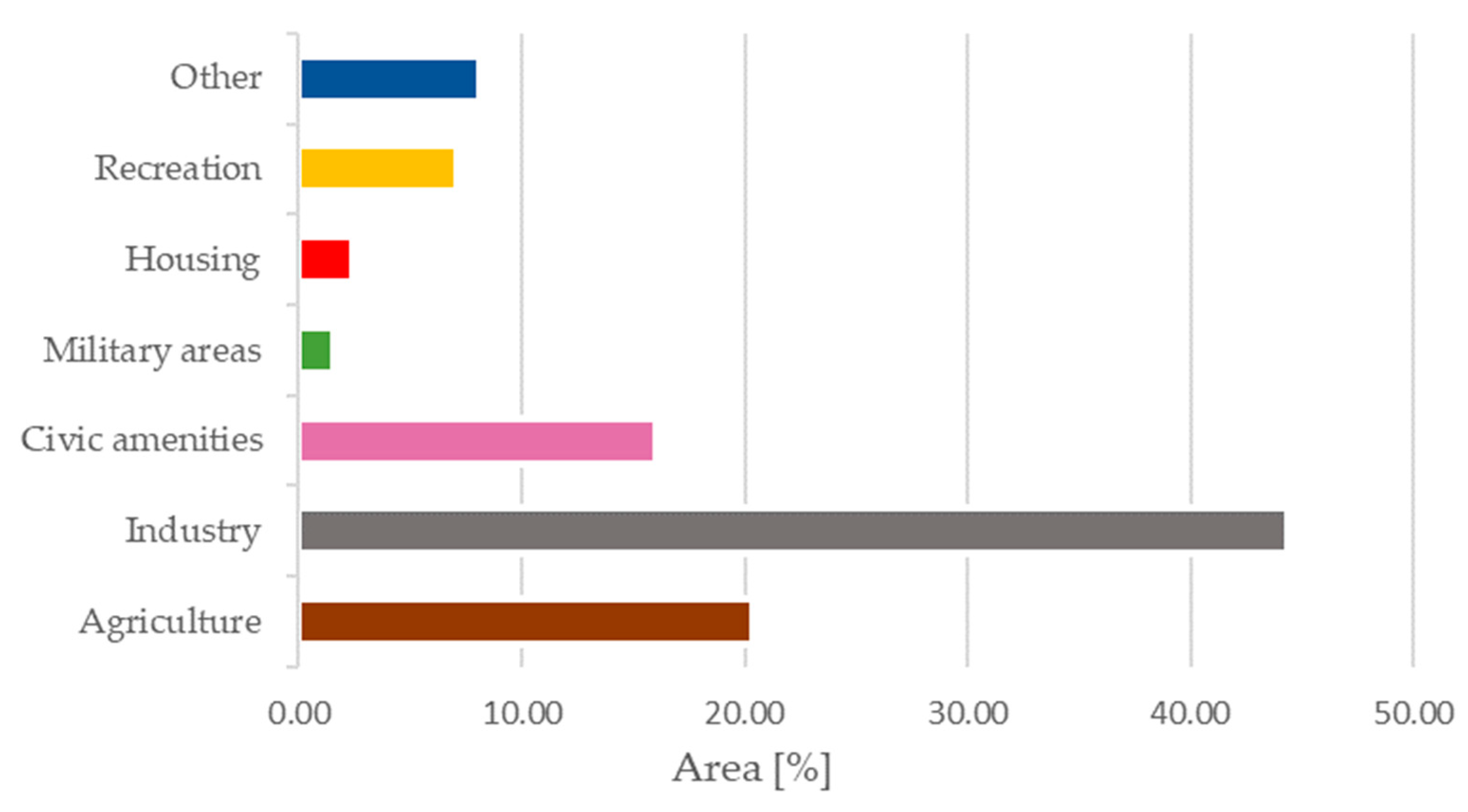
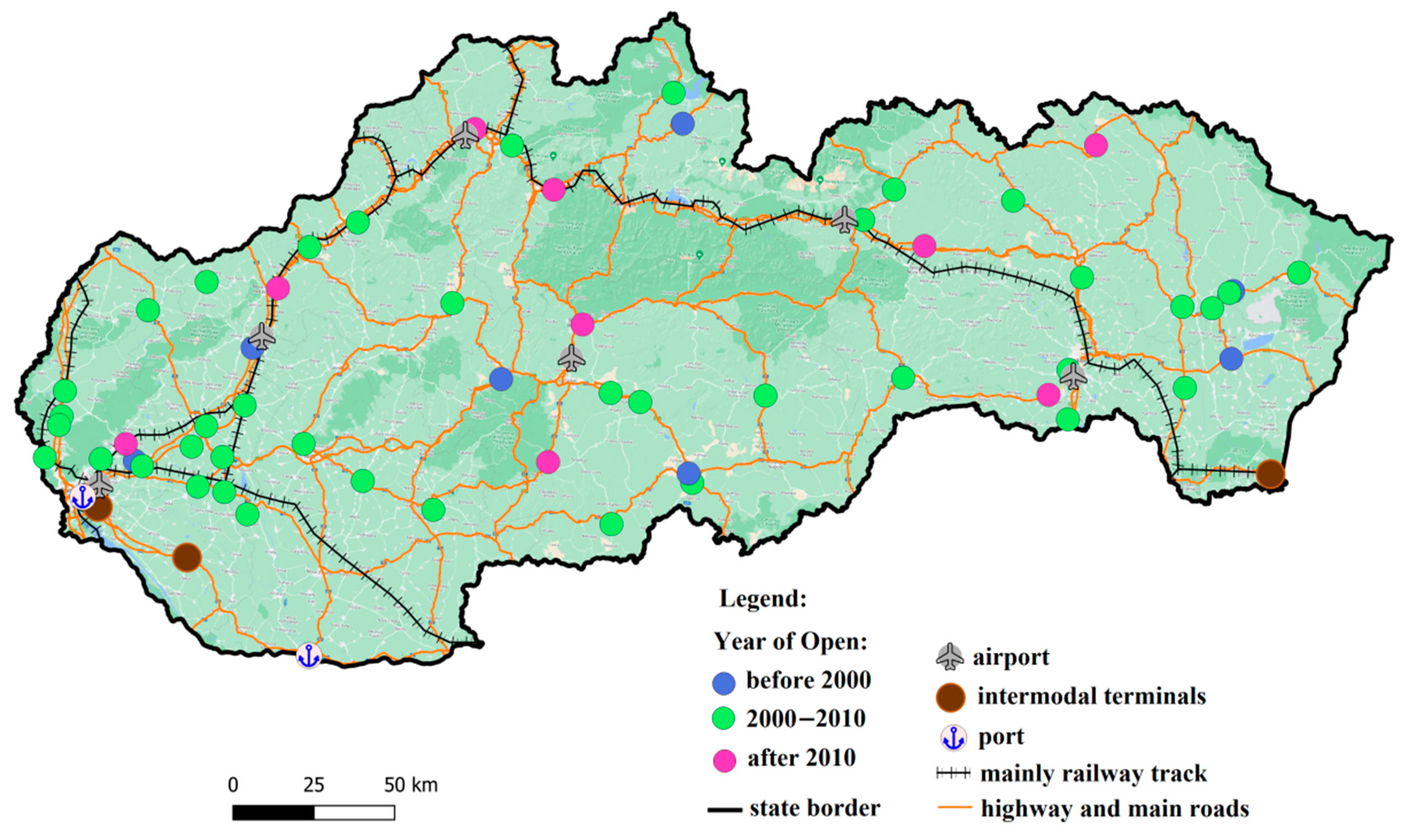


Publisher’s Note: MDPI stays neutral with regard to jurisdictional claims in published maps and institutional affiliations. |
© 2021 by the authors. Licensee MDPI, Basel, Switzerland. This article is an open access article distributed under the terms and conditions of the Creative Commons Attribution (CC BY) license (https://creativecommons.org/licenses/by/4.0/).
Share and Cite
Izakovičová, Z.; Petrovič, F.; Pauditšová, E. The Impacts of Urbanisation on Landscape and Environment: The Case of Slovakia. Sustainability 2022, 14, 60. https://doi.org/10.3390/su14010060
Izakovičová Z, Petrovič F, Pauditšová E. The Impacts of Urbanisation on Landscape and Environment: The Case of Slovakia. Sustainability. 2022; 14(1):60. https://doi.org/10.3390/su14010060
Chicago/Turabian StyleIzakovičová, Zita, František Petrovič, and Eva Pauditšová. 2022. "The Impacts of Urbanisation on Landscape and Environment: The Case of Slovakia" Sustainability 14, no. 1: 60. https://doi.org/10.3390/su14010060
APA StyleIzakovičová, Z., Petrovič, F., & Pauditšová, E. (2022). The Impacts of Urbanisation on Landscape and Environment: The Case of Slovakia. Sustainability, 14(1), 60. https://doi.org/10.3390/su14010060





